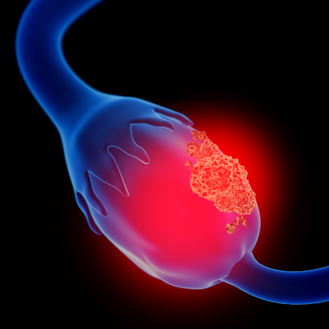
December 19, 2022
By Olubunmi Ajao, Drexel University College of Medicine
About Ovarian Cancer
Cancer is a condition in which cells within the body rapidly grow out of control. The type of cancer is determined by the site where it began, regardless of whether it has spread. There are six main types of female reproductive cancers including vulvar, vaginal, cervical, uterine, fallopian and ovarian. Ovarian cancer is the second most common reproductive cancer and the deadliest gynecological tumor in the Unites States.
About the Ovaries
The ovary is a small almond-sized reproductive organ. Women have two ovaries, one located on each side within the pelvis. The ovaries are the site of female hormone production and storage of eggs. They consist of different types of tissues including epithelial cells, germ cells and stromal tissue, which can give rise to a variety of benign or malignant tumors.
Risk Factors for Ovarian Cancer
While there is no definitive way to determine who will get ovarian cancer in the future, there are many factors that can increase an individual’s risk. Everyone with ovaries is at risk for ovarian cancer. In general, the incidence of ovarian cancer increases with age. There are genetic dispositions, such as BRCA1/BRCA2 or MLH mutations, that can increase a woman’s lifetime risk of developing ovarian cancer. Eastern European Ashkenazi Jewish ancestry is also associated with an increased risk. Having personal or close familial history of breast, colorectal or uterine cancer can also raise a woman’s chance of getting ovarian cancer. In addition, there are hormonal factors that can impact a woman’s risks, including an increased number of lifetime ovulations; this can be due to few or no pregnancies, early onset of menses, late onset of menopause and prolonged hormone replacement therapies.
Signs and Symptoms of Ovarian Cancer
While it was previously thought that ovarian cancer was asymptomatic and the “silent killer,” it is now recognized that up to 90% of patients do present with symptoms prior to diagnosis. Ovarian cancer can present in many ways. The symptoms often depend on the type of ovarian tissue that may be affected. Some women may experience abnormal post-menopausal vaginal bleeding or discharge from the vagina. Others may experience changes in elimination habits such as increased urinary frequency or constipation.
Screening for Ovarian Cancer
Routine screening is not recommended in average-risk women. Thus, women should be encouraged to make note when changes to the body occur that may be signs of ovarian cancer. For those with higher risks, a family risk assessment should be done followed by genetic counseling and testing, if indicated.
Treatment for Ovarian Cancer
Treatment and research are constantly evolving and should be discussed with a gynecologic oncologist. Options often vary from person to person based on needs and the type of ovarian cancer. Some treatment options include surgical interventions, chemotherapy and radiation therapy.
Ovarian Cancer Prevention
While there is no known way to prevent ovarian cancer in women, there are hormonal and non-hormonal factors that may reduce and individual’s risk. The use of oral contraception, increased number of pregnancies, and breastfeeding newborns seem to serve as hormonal protective factors. Non-hormonal factors include surgical interventions such as removal of both ovaries and fallopian tubes and/or uterus.
Support
Outside of the care team, family and friends, there are many support groups that one can join when diagnosed with ovarian cancer. Patients come from many different backgrounds with many different perspectives, but come together to empower, support and uplift each other.
Sources/Resources:
- “Epidemiology of ovarian cancer: a review.” Brett MR, Jennifer BP, Thomas AS. Cancer Biol Med. 2017; 14(1): p.9-32.
- “Ovarian Cancer Prevention, Screening, and Early Detection: Report From the 11th Biennial Ovarian Cancer Research Symposium.” Jeremy Chien and Elizabeth M. Poole. International Journal of Gynecological Cancer: official journal of the International Gynecological Cancer Society vol. 27,9S Suppl 5 (2017)
- Ovarian Cancer Statistics. https://www.cdc.gov/cancer/ovarian/statistics/index.htm. Updated: June 5, 2022. Accessed: September 26, 2022.